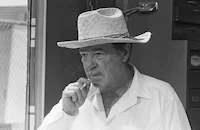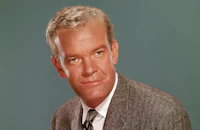In Like Flint

Brief Synopsis
Cast & Crew
Gordon Douglas
James Coburn
Lee J. Cobb
Jean Hale
Andrew Duggan
Anna Lee
Film Details
Technical Specs

Synopsis
As the United States prepares its latest space launching from a remote site in the Virgin Islands, a secret society of women plans to conquer the world. Using a beauty resort called "Fabulous Face" as a front, they put their master plan into operation by abducting the President of the United States from a golf course and replacing him with a look-alike. Special Pentagon official Cramden senses a conspiracy and calls on secret agent Derek Flint for help, but Lisa, an agent for Fabulous Face, drugs Cramden and discredits him by having him photographed in bed with her. In addition, Flint's three favorite girl friends are abducted by the secret society and temporarily frozen into suspended life. After a side trip to the Soviet Union, Flint uses his innumerable gadgets to penetrate the Fabulous Face headquarters. Cramden, who attempts entry by disguising himself as a woman, is discovered and thrown into a cell with the President. Meanwhile, General Carter, a traitorous Army officer, is planning to double-cross Fabulous Face and further his own chances for world conquest by transforming the rocket into a nuclear device. However, as the rocket is prepared for blast-off, Flint and the Fabulous Face agents combine forces against their common enemy. Carter launches himself into space, intending to destroy the world, but the pursuing Flint overpowers him, thereby saving his girl friends, Cramden, the President, and the world.

Director

Gordon Douglas
Cast

James Coburn

Lee J. Cobb
Jean Hale

Andrew Duggan

Anna Lee
Hanna Landy
Totty Ames
Steve Ihnat
Thomas Hasson
Mary Michael
Diane Bond
Jacki Ray
Herbert Edelman

Yvonne Craig
Buzz Henry
Henry Wills
John Lodge
Mary Meade French

Erin O'brien
Ginny Gan
Eve Bruce
Inge Jaklyn
Kay Farrington
Thordis Brandt
Inga Neilsen
Marilyn Hanold
Pat Becker
Lyzanne La Due
Nancy Stone
W. P. Lear Sr.
Crew
L. B. Abbott
Ray Aghayan
Ballet Of Los Angeles
Leslie Bricusse
Art Cruickshank
William H. Daniels
Saul David
David Dockendorf
Margaret Donovan
Hal Fimberg
Martin Fink
Hugh S. Fowler
Jerry Goldsmith
Jerry Goldsmith
Samuel F. Goode
David Hall
Dale Hennesy
Buzz Henry
Emil Kosa Jr.
Richard Kuhn
Martin Of California
Arthur Morton
National Screen Service
Ben Nye
James W. Payne
Walter M. Scott
Jack Martin Smith
Eric Stacey
Stefan Wenta

Film Details
Technical Specs

Articles
In Like Flint
Flint's maiden mission, Our Man Flint (1966), premiered in the wake of Eon Productions' fourth James Bond outing, Thunderball (1965). That film marked something of a crossroads for the Connery-Bond films, as the star of the show grew stockier (and crankier) with age and success and the films became less lean-and-mean and more gadget-based. Our Man Flint offered a more tenable working agent in former movie heavy James Coburn, who brought to the table a unique blend of atypical good looks and an almost Pierrot-like grace that allowed him to best villains hand-to-hand without appearing thug-like. Paired with an immediate sequel, In Like Flint (1967), the series split the difference between the high comedy of Get Smart and the parade of female flesh that was the stock-in-trade of Eon Productions but largely prohibited on network television. Character creator Hal Fimberg was a former Vaudevillian who had contributed to the screenplays of the wartime Abbott and Costello vehicles In Society (1944) and The Naughty Nineties (1945) before turning his talents to episodic television.
Hoping to reap big profits, 20th Century Fox kept its overhead low on the Flint films, casting contract players in the supporting roles, keeping shooting confined for the most part to studio interiors, and assigning production to utility directors. While Daniel Mann held the reins on Our Man Flint, the sequel was put into the hands of Gordon Douglas. Better remembered now for such gritty dramas as Only the Valiant (1951) starring Gregory Peck, the sci-fi classic Them! (1954) and the violent western Chuka (1967) with Rod Taylor, Douglas had got his start as a gag writer for Hal Roach before graduating to directing early "Our Gang" shorts and the later Laurel & Hardy comedy Saps at Sea (1940). If Fox regarded the Bond films as a business model, In Like Flint swings wide of its inspiration in execution, keeping Flint off screen for the first fifteen minutes while costar Lee J. Cobb serves as the plot's point man in a tale of international espionage within the aerospace industry and a bid to place a lookalike agent in the Oval Office. Introduced in a wry sidebar as Flint attempts to master dolphinese, Coburn is not handed the ball until forty minutes in, at which point he breaks into a top secret government installation before decamping to Moscow and a pas de deus with ballerina/informer Yvonne Craig (soon to be introduced by Fox as TV's Batgirl), a pretty Party member who is a sucker for his decadence.
In Like Flint (a play on the 40s catchphrase "In like Flynn," a testament to the cocksmanship of movie idol Errol Flynn) was the last 20th Century Fox production filmed in CinemaScope. It is only in the film's second hour that the widescreen process asserts itself, first as Flint insinuates himself (with aplomb!) into a ballet on the stage of the Bolshoi Theatre and later while evading a goon squad of K.G.B. agents in a foot chase across the snow-capped rooftops of Moscow. The use of matte paintings by Emil Kosa, Jr., L. B. Abbott and Art Cruickshank (all of whom would be pressed into service for Planet of the Apes [1968] the following year) give In Like Flint a sense of wonder and majesty and a scale that is conducive to international (and interstellar) skullduggery, aided immeasurably by the invigorating score by Jerry Goldsmith. However poor its supporting cast may be in name recognition factor, the sequel receives added value through the performances of Cobb (particularly fine in an early scene with enemy agent Jean Hale), Steve Ihnat (as an army turncoat), Andrew Duggan (in a dual role as an LBJ simulacra and his evil twin), Anna Lee (in evil genius mode) and Herb Edelman, in his feature film debut as a Soviet premier.
In Like Flint put Coburn over the top as a proper movie star, giving him an instant recognition factor that stretched from Beverly Hills to the alleys of Marrakesh. Fox would have pressed the actor into further service in a second Flint sequel but by 1967 Coburn had founded his own production company and was pointed towards greater glory, with name-above-the-title status in such diverse films as The President's Analyst (1967), the Donald Cammell-scripted Duffy (1968) and Sergio Leone's Duck, You Sucker! (1971), as well as several collaborations with maverick filmmaker Sam Peckinpah. A known associate of both Steve McQueen and Bruce Lee, Coburn shared with Flint a love of the esoteric and offbeat, agreeing to lend his brand to such non-blockbusters as Candy (1968), The Last of Sheila (1973) and the rodeo drama The Honkers (1972), directed by his In Like Flint castmate Steve Ihnat, who died of a heart attack while selling the film at the 1972 Cannes Film Festival. The diagnosis of rheumatoid arthritis in 1978 knocked Coburn off the A-list for nearly two decades, with the actor limiting himself to guest appearances and voiceover work on screens big and small until he declared himself cured through alternative medicines - just in time to nab a 1999 Academy Award for his acidic performance as Nick Nolte's dissolute father in Paul Schrader's Affliction (1997).
Producer: Saul David, Martin Fink
Director: Gordon Douglas
Screenplay: Hal Fimberg
Cinematography: William H. Daniels
Editing: Hugh S. Fowler
Art Direction: Dale Hennesy, Jack Martin Smith
Music: Jerry Goldsmith
Cast: James Coburn (Derek Flint), Lee J. Cobb (Lloyd C. Cramden), Jean Hale (Lisa Norton/Nora Benson), Andrew Duggan (U.S. President Trent), Anna Lee (Elisabeth), Hanna Landy (Helena), Steve Ihnat (Gen. Carter), Yvonne Craig (Natasha).
C-114m.
By Richard Harland Smith
Sources:
James Coburn interview by Roger Ebert, Chicago-Sun Times, October 26, 1980
James Coburn interview by Alex Simon, Venice, February 1999
"Flint Lives!" by Tim Lucas, Video Watchdog, no. 92, 2003
The Incredible World of Spy-Fi: Wild and Crazy Spy Gadgets, Props and Artifacts from TV and the Movies by Danny Biederman (Chronicle Books, 2004)

In Like Flint
Quotes
An actor? As president?- Flint
Trivia
Notes
Location scenes filmed in Jamaica. The film is a sequel to Our Man Flint, q. v.

Miscellaneous Notes
Released in United States on Video January 4, 1990
Released in United States Winter January 1, 1967
CinemaScope
Released in United States Winter January 1, 1967
Released in United States on Video January 4, 1990














